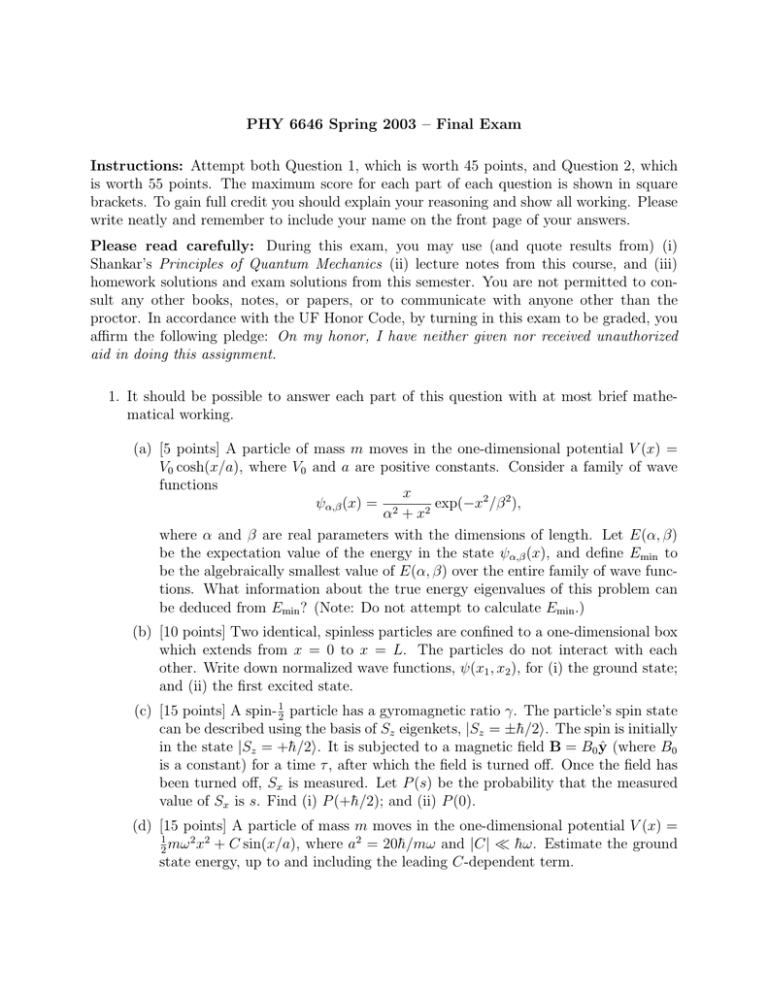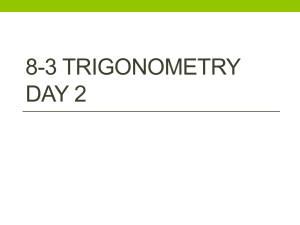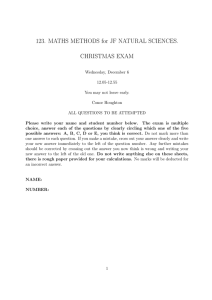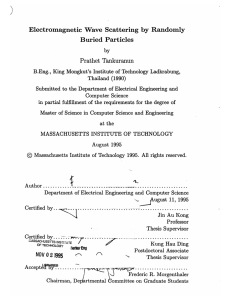PHY 6646 Spring 2003 – Final Exam Instructions:
advertisement

PHY 6646 Spring 2003 – Final Exam Instructions: Attempt both Question 1, which is worth 45 points, and Question 2, which is worth 55 points. The maximum score for each part of each question is shown in square brackets. To gain full credit you should explain your reasoning and show all working. Please write neatly and remember to include your name on the front page of your answers. Please read carefully: During this exam, you may use (and quote results from) (i) Shankar’s Principles of Quantum Mechanics (ii) lecture notes from this course, and (iii) homework solutions and exam solutions from this semester. You are not permitted to consult any other books, notes, or papers, or to communicate with anyone other than the proctor. In accordance with the UF Honor Code, by turning in this exam to be graded, you affirm the following pledge: On my honor, I have neither given nor received unauthorized aid in doing this assignment. 1. It should be possible to answer each part of this question with at most brief mathematical working. (a) [5 points] A particle of mass m moves in the one-dimensional potential V (x) = V0 cosh(x/a), where V0 and a are positive constants. Consider a family of wave functions x exp(−x2 /β 2 ), ψα,β (x) = 2 2 α +x where α and β are real parameters with the dimensions of length. Let E(α, β) be the expectation value of the energy in the state ψα,β (x), and define Emin to be the algebraically smallest value of E(α, β) over the entire family of wave functions. What information about the true energy eigenvalues of this problem can be deduced from Emin ? (Note: Do not attempt to calculate Emin .) (b) [10 points] Two identical, spinless particles are confined to a one-dimensional box which extends from x = 0 to x = L. The particles do not interact with each other. Write down normalized wave functions, ψ(x1 , x2 ), for (i) the ground state; and (ii) the first excited state. (c) [15 points] A spin- 12 particle has a gyromagnetic ratio γ. The particle’s spin state can be described using the basis of Sz eigenkets, |Sz = ±h̄/2i. The spin is initially in the state |Sz = +h̄/2i. It is subjected to a magnetic field B = B0 ŷ (where B0 is a constant) for a time τ , after which the field is turned off. Once the field has been turned off, Sx is measured. Let P (s) be the probability that the measured value of Sx is s. Find (i) P (+h̄/2); and (ii) P (0). (d) [15 points] A particle of mass m moves in the one-dimensional potential V (x) = 1 mω 2 x2 + C sin(x/a), where a2 = 20h̄/mω and |C| h̄ω. Estimate the ground 2 state energy, up to and including the leading C-dependent term. 2. A particle of mass m scatters from the spherical square-well potential V (r) = −V0 0 for r < a, otherwise, where V0 > 0 and a > 0. (a) [10 points] Calculate the scattering amplitude f (q) within the first Born approximation. Here, q = 2k sin(θ/2) is the magnitude of the momentum transfer. (b) [15 points] Use your result from (a) to show that for ka 1, the Born scattering cross section σBorn is (4ma2 V0 /3h̄2 )2 times the geometric cross section. (c) [5 points] Over what range of the V0 would you expect σBorn to be a good approximation to the true cross section σ? (d) [5 points] The scattering cross section can also be obtained via partial wave analysis. Over what range of parameters should σ be well-approximated by the s-wave partial cross section, σ0 ? (e) [20 points] For the spherical square-well potential, you found in Homework 10, Question 4 (Shankar Exercise 19.5.4) that ! −1 δ0 = tan k tan k 0 a − ka, k0 where k 0 is the wavevector inside the well. Show that the scattering cross section obtained from δ0 agrees with that derived using the Born approximation, provided that the validity conditions you identified in parts (c) and (d) are both satisfied. Mathematical Formulae For |x| 1, sin x ≈ x − x3 /6 cos x ≈ 1 − x2 /2 tan x ≈ x + x3 /3 Double-angle formulae: sin(x + y) = sin x cos y + cos x sin y cos(x + y) = cos x cos y − sin x sin y tan x + tan y tan(x + y) = 1 − tan x tan y






